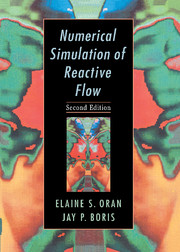Book contents
- Frontmatter
- Contents
- Prologue
- 1 An Overview of Numerical Simulation
- 2 The Reactive-Flow Modeling Problem
- 3 Models and Simulation
- 4 Some General Numerical Considerations
- 5 Ordinary Differential Equations: Reaction Mechanisms and Other Local Phenomena
- 6 Representations, Resolution, and Grids
- 7 Diffusive Transport Processes
- 8 Computational Fluid Dynamics: Continuity Equations
- 9 Computational Fluid Dynamics: Using More Flow Physics
- 10 Boundaries, Interfaces, and Implicit Algorithms
- 11 Coupling Models of Reactive-Flow Processes
- 12 Turbulent Reactive Flows
- 13 Radiation Transport and Reactive Flows
- Index
12 - Turbulent Reactive Flows
Published online by Cambridge University Press: 09 October 2009
- Frontmatter
- Contents
- Prologue
- 1 An Overview of Numerical Simulation
- 2 The Reactive-Flow Modeling Problem
- 3 Models and Simulation
- 4 Some General Numerical Considerations
- 5 Ordinary Differential Equations: Reaction Mechanisms and Other Local Phenomena
- 6 Representations, Resolution, and Grids
- 7 Diffusive Transport Processes
- 8 Computational Fluid Dynamics: Continuity Equations
- 9 Computational Fluid Dynamics: Using More Flow Physics
- 10 Boundaries, Interfaces, and Implicit Algorithms
- 11 Coupling Models of Reactive-Flow Processes
- 12 Turbulent Reactive Flows
- 13 Radiation Transport and Reactive Flows
- Index
Summary
Any attempt to define turbulence in a few words, or even a few lines, would probably invite argument and cause confusion. Turbulence is best described by a few of its characteristics. Turbulent flows are generally high Reynolds-number flows that appear to be irregular or random. Turbulent fluid motions are complex and contain many different time and space scales all coexisting in the same volume of fluid. In the terminology used in Section 11–5.1, turbulence is generally a homogeneous phenomena in the sense that all of the important scales present, microscopic through macroscopic, occupy the same space simultaneously, and it is contiguous in the sense that the relevant spatial and temporal scales are very close or overlapping. Experiments on turbulent flows are not microscopically reproducible from one time to the next.
Perhaps the most important aspect of turbulence for reactive flows is that it provides an efficient way for distinct, initially separate materials to interpenetrate and mix. Turbulence greatly increases the rates of heat, mass, and momentum transfer, as well as interspecies mixing, which is usually a necessary precursor for chemical reactions. This rapid mixing is caused by the spectrum of vortices in the flow, which act to increase the surface area of the interface between different and partially unmixed materials. As the interface surface area increases, proportionately more material diffuses across this interface, so that more molecular-scale mixing occurs. Therefore, a turbulent flame with its convoluted surface area propagates faster than a laminar (nonturbulent) flame because of the resulting faster energy release. On the computational side, the addition of chemical reactions and heat release makes it more expensive to simulate reacting turbulent flows than nonreacting turbulent flows.
- Type
- Chapter
- Information
- Numerical Simulation of Reactive Flow , pp. 443 - 487Publisher: Cambridge University PressPrint publication year: 2000



